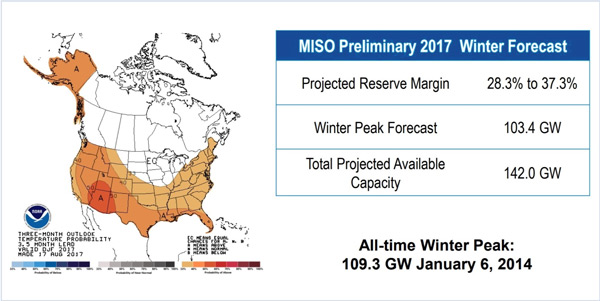By Amanda Durish Cook
MISO last week said it expects to have plenty of reserve capacity to cover upcoming winter operations, even as it announced a review of an emergency declaration made on the first day of fall when a heat wave pushed reserves to their acceptable limits.
The RTO’s preliminary forecast predicts a 28.3 to 37.3% reserve margin this winter, with about 142 GW of capacity on hand to meet an anticipated peak load of 103.4 GW, according to Rob Benbow, MISO senior director of systemwide operations.
“I would say this is a little colder-than-normal winter, but not by much. This is pretty typical of the last few years,” Benbow said during an Oct. 5 Reliability Subcommittee meeting.
MISO’s all-time winter peak of 109.3 GW occurred Jan. 6, 2014, during the so-called “polar vortex.”
Final values for forecasted winter capacity will be presented Nov. 6 at a MISO Winter Readiness Workshop.
Benbow reminded stakeholders that MISO’s gas usage profile-sharing program will begin in December. Under the pilot program aimed at improving gas-electric coordination, the RTO will share hourly day-ahead gas usage profiles with a trio of selected gas system operators. (See FERC Approves MISO Plan to Share Generator Gas Data.)
Mark Thomas, electric-gas operations coordinator, said MISO is collecting data for its fourth annual gas-fired generation winter fuel survey, which focuses on generators’ winter preparedness efforts. Thomas said 87% of MISO’s gas-fired capacity participated in last year’s survey.
September Emergency
But even as MISO transitions to colder weather, it plans to review emergency operations spurred by an unexpected late summer/early fall heat wave.
MISO staff will offer a more detailed report on a late September maximum generation event during its Oct. 12 Market Subcommittee meeting, Benbow said.
The event began to unfold 11 a.m. on Sept. 21 when the RTO initiated conservative operations measures in response to average temperatures reaching nearly 90 F, which produced a peak load approaching 109 GW. Peak load hit 114.7 GW the following day when temperatures climbed to 92 F, prompting MISO to declare a maximum generation event between 2 p.m. and 6:15 p.m. ET. The RTO declared another emergency warning Sept. 23 and finally lifted conservative operations at 8 p.m. on Sept. 26.
Benbow said a mixture of record temperatures, high load, and seasonal and forced generation outages contributed to the “challenging conditions.”
“Typical load this time of year might be 80 GW and even lower on the weekend,” Benbow said. “This heat dome was really caused by hurricanes stalling the [weather] system in our footprint.”
Benbow said the planning model did not forecast such extreme temperatures, and MISO staff are reviewing the RTO’s actions ― along with the outages ― leading up to the event. MISO has considered a possible expanded role in outage coordination since its Independent Market Monitor earlier this year recommended the RTO have a greater say in approving outages to reduced costs and instances of emergency situations. (See MISO in Harmony with IMM State of the Market Report.)
Some stakeholders last month also voiced support for more sophisticated outage planning between generators and transmission owners.
“I don’t believe that anyone had to shed load at any time. … Congratulations for keeping it together,” Indianapolis Power and Light’s Lin Franks said of MISO’s latest emergency declaration.
Benbow confirmed that no load shedding occurred during the five-day event.



